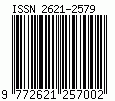Decoding Inclusive Beauty: Audience Reception to Beauty Standards and Disability in Digital Media Advertisements
DOI:
https://doi.org/10.12928/channel.v13i1.1080Keywords:
Advertisements, Audience reception, Digital advertising, Disability representation, Inclusive beautyAbstract
This study explores how Indonesian audiences interpret beauty standards in digital advertisements featuring models with disabilities and examines how digital media shapes perceptions of beauty and diversity. Drawing on a qualitative approach grounded in a constructivist paradigm, this research applies Stuart Hall’s reception theory and Roland Barthes’s semiotics to analyze two popular beauty advertisements: Pond’s #WajahmuKekuatanmu (2022) and Wardah #BeautyMovesYou (2021). Data were collected through in-depth interviews with eight informants aged 18–25. Findings indicate that although both advertisements incorporate models with disabilities, their messages are interpreted differently. Pond’s ad was perceived as reinforcing conventional beauty myths, focusing on flawless skin and idealized aesthetics, whereas Wardah’s ad was more positively received for promoting empowerment and inclusion, though still subject to critique for retaining elements of perfection. Audience responses were categorized into dominant, negotiated, and oppositional readings, revealing a critical engagement with how disability and beauty are portrayed. The study highlights a gendered dimension in audience interpretation, with female informants generally more receptive to inclusive messages. It recommends that advertisers ensure authenticity by involving disability communities in production processes to avoid tokenism and misrepresentation. This research contributes to digital media and disability studies by underlining the need for deeper shifts in narrative, substance, and visual representation to achieve meaningful inclusion.
References
Abid, S. (2021). On Being and Becoming Beautiful: The Social Construction of Feminine Beauty. Pakistan Social Sciences Review, 5(II), 403–413. https://doi.org/10.35484/pssr.2021(5-ii)33
Akhtar, S. (2024). Discrimination and the exclusion of people with disabilities. Ethics & Global Politics, 17(2–3), 68–82. https://doi.org/10.1080/16544951.2024.2361562
Al Fajri, M. S., Abdul Rahim, H., & Rajandran, K. (2024). Portraying people with disability in Indonesian online news reports: a corpus-assisted discourse study. Media Asia, 51(4), 548–569. https://doi.org/10.1080/01296612.2024.2310891
Allen, G. (2003). Roland Barthes (1st edi). Routledge. https://doi.org/https://doi.org/10.4324/9780203634424
Amalia, F. A., Andani, A. R., & Guteres, A. D. (2024). The Perception of Young Women towards Beauty Value in Beauty Advertisements. Journal of Marketing Innovation (JMI), 3(1). https://doi.org/10.35313/jmi.v3i1.63
Bakombo, S., Ewalefo, P., & Konkle, A. T. M. (2023). The Influence of Social Media on the Perception of Autism Spectrum Disorders: Content Analysis of Public Discourse on YouTube Videos. International Journal of Environmental Research and Public Health (Vol. 20, Issue 4). https://doi.org/10.3390/ijerph20043246
Barnes, C. (2008). Generating change: Disability, culture and art. Behinderung und Dritte Welt (Journal for Disability and International Development), 19(1), 4-13. Retrieved from https://disability-studies.leeds.ac.uk/wp-content/uploads/sites/40/library/Barnes-Generating-Change.pdf
Bolt, D. (2014). An advertising aesthetic: Real beauty and visual impairment. British Journal of Visual Impairment, 32(1), 25–32. https://doi.org/10.1177/0264619613512619
Borgerson, J. L., & Schroeder, J. E. (2002). Ethical issues of global marketing: avoiding bad faith in visual representation. European Journal of Marketing, 36(5–6), 570–594. https://doi.org/10.1108/03090560210422399
Creswell, J. W. (2009). Research Design: Qualitative, Quantitative, and Mixed Methods Approaches (3rd ed.). SAGE Publications, Inc. http://libgen.li/file.php?md5=b99ab993cd369288368621be19a5333d
de Lenne, O., Vandenbosch, L., Smits, T., & Eggermont, S. (2021). Framing real beauty: A framing approach to the effects of beauty advertisements on body image and advertising effectiveness. Body Image, 37, 255–268. https://doi.org/https://doi.org/10.1016/j.bodyim.2021.03.003
Denzin, N. K., Lincoln, Y. S., Giardina, M. D., & Cannella, G. S. (2024). The SAGE handbook of qualitative research (6th ed.). SAGE.
Etikan, I., Musa, S. A., & Alkassim, R. S. (2016). Comparison of Convenience Sampling and Purposive Sampling. 5(1), 1–4. https://doi.org/10.11648/j.ajtas.20160501.11
Forstner, M. (2022). Conceptual Models of Disability: The Development of the Consideration of Non-Biomedical Aspects. In Disabilities (Vol. 2, Issue 3, pp. 540–563). https://doi.org/10.3390/disabilities2030039
Foster, J., & Pettinicchio, D. (2022). A model who looks like me: Communicating and consuming representations of disability. Journal of Consumer Culture, 22(3), 579–597. https://doi.org/10.1177/14695405211022074
Griffin, E. (1998). A First Look at Communication Theory. In A First Look at Communication Theory (4th ed.). McGraw-Hill.
Hall, S. (1973). Encoding and decoding in the television discourse. CCCS Selected Working Papers, September. https://doi.org/10.4324/9780203357071-35
Hall, S. (1982). The rediscovery of ideology: Return of the repressed in media studies. In B. Tony, C. James, G. Michael, & W. Janet (Eds.), Culture, Society and the Media (1st edi, pp. 59–90). Routledge.
Henderson, G. R., & Rank-Christman, T. (2016). Diversity and consumer behavior. Current Opinion in Psychology, 10, 148–153. https://doi.org/https://doi.org/10.1016/j.copsyc.2016.01.006
Houston, E. (2019). ‘Risky’ representation: the portrayal of women with mobility impairment in twenty-first-century advertising. Disability & Society, 34(5), 704–725. https://doi.org/10.1080/09687599.2019.1576505
Houston, E. (2022). Polysemic Interpretations: Examining How Women with Visual Impairments Incorporate, Resist, and Subvert Advertising Content. Journal of Advertising, 51(2), 240–255. https://doi.org/10.1080/00913367.2021.1895008
Kumala, A. D., & Sukmono, F. G. (2023). Exploring Society’s Views on Gender Role Reversal in Kudapan Spesial Movie: An Analysis Using Reception Analysis and Constructivism Paradigm. CHANNEL: Jurnal Komunikasi, 11(1 SE-Articles), 55–60. https://doi.org/10.12928/channel.v11i1.94
Katadata Insight Center. (2023, March 24). Top Brand Survey: Pasta gigi dan sabun muka. Databoks. Retrieved from https://databoks.katadata.co.id/publikasi/2023/03/24/top-brand-survey-pasta-gigi-dan-sabun-muka
Kusumawati, Y. A., Budiwaspada, A. E., & Saidi, A. I. (2016). Makna Kecantikan pada Iklan Televisi Kosmetik Berlabel Halal (Studi Kasus: Mazaya Divine Beauty). Jurnal Sosioteknologi, 15(1), 96–105. https://doi.org/https://doi.org/10.5614/sostek.itbj.2016.15.1.9
Lestari, E. M. I. (2020). A Critical Discourse Analysis of The Advertisement of Japanese Beauty Products. Izumi, 9(1), 58–74. https://doi.org/https://doi.org/10.14710/izumi.9.1.58-74
Maftuhin, A. (2016). Mengikat Makna Diskriminasi: Penyandang Cacat, Difabel, dan Penyandang Disabilitas. INKLUSI, 3(2 SE-Articles), 139–162. https://doi.org/10.14421/ijds.030201
Murillo Lafuente, I. E. (2023). Spaces of Anti-Ableist, Feminist Resistance. Space and Culture, 26(3), 433–450. https://doi.org/10.1177/12063312231181529
Nelson, M. R., & Cook, K. (2023). Assessing Student Knowledge About Disabilities and Filling the Gap: Including Disability and Accessibility Content Into the Advertising Classroom. Journal of Advertising Education, 27(1), 23–49. https://doi.org/10.1177/10980482221141379
Niyu, N. (2017). Representasi Disabilitas dalam Iklan “We’re the Superhumans.” Inklusi, 4(1), 49. https://doi.org/10.14421/ijds.040103
Parker, K., & Igielnik, R. (2020). On the Cusp of Adulthood and Facing an Uncertain Future: What We Know About Gen Z So Far. https://www.pewresearch.org/social-trends/2020/05/14/on-the-cusp-of-adulthood-and-facing-an-uncertain-future-what-we-know-about-gen-z-so-far-2/
Prianti, D. D. (2013). Indonesian female beauty concept: Does it take into account the traditional values. Proceedings of The Asian Conference on Media and Mass Communication, 346–357.
Qayyum, A., Jamil, R. A., Shah, A. M., & Lee, K. (2023). Inclusive advertising featuring disability on instagram: Effect on consumer well-being, brand engagement, and purchase intention. Journal of Retailing and Consumer Services, 75, 103515. https://doi.org/https://doi.org/10.1016/j.jretconser.2023.103515
Rohmah, F. N., & Suhardi, S. (2020). Critical discourse analysis on TV advertisements for beauty products. Indonesian Journal of EFL and Linguistics, 5(2), 453.
Rosadi, D. (2022). Terbatas, Akses Bekerja Perempuan Penyandang Disabilitas. Katadata.Co.Id. https://katadata.co.id/berita/nasional/622820e43e073/terbatas-akses-bekerja-perempuan-penyandang-disabilitas
Selensky, J. C., & Carels, R. A. (2021). Weight stigma and media: An examination of the effect of advertising campaigns on weight bias, internalized weight bias, self-esteem, body image, and affect. Body Image, 36, 95–106. https://doi.org/https://doi.org/10.1016/j.bodyim.2020.10.008
Setyowati, R. M., Setya Watie, E. D., & Saptiyono, A. (2020). Representation of Disability Achievements in Television Talk Show Programs. Jurnal The Messenger; Vol 12, No 1 (2020): January-JuneDO - 10.26623/Themessenger.V12i1.1587 . https://journals.usm.ac.id/index.php/the-messenger/article/view/1587
Shelton, S. S., & Waddell, T. F. (2021). Does ‘Inspiration Porn’ Inspire? How Disability and Challenge Impact Attitudinal Evaluations of Advertising. Journal of Current Issues & Research in Advertising, 42(3), 258–276. https://doi.org/10.1080/10641734.2020.1808125
Slater, S., & Demangeot, C. (2021). Marketer acculturation to diversity needs: The case of modest fashion across two multicultural contexts. Journal of Business Research, 134, 702–715. https://doi.org/https://doi.org/10.1016/j.jbusres.2021.05.059
Södergren, J., Hietanen, J., & Vallström, N. (2023). Tales from the crypt: A psychoanalytic approach to disability representation in advertising. Journal of Consumer Culture, 23(4), 747–768. https://doi.org/10.1177/14695405221140543
Statista. (2024). Beauty & Personal Care - Indonesia. https://www.statista.com/outlook/cmo/beauty-personal-care/indonesia
Swastika, G., Audrey, F., & Purnomo, F. (2022). Content Marketing Analysis of Body Positivity Campaign on Instagram: Case Study of Nipplets. CHANNEL: Jurnal Komunikasi, 10(2 SE-Articles), 133–142. https://doi.org/10.12928/channel.v10i2.90
Veloo, V., & Mustafa, S. E. (2023). The influence of beauty standards in local beauty advertisements among female millennials in Klang Valley, Malaysia. SEARCH Journal of Media and Communication Research, 15(2), 1–15.
Wolf, N. (2002). The Beauty Myth: How Images of Beauty Are Used Against Women. Haper Collins.
Downloads
Published
How to Cite
Issue
Section
License
Copyright (c) 2025 CHANNEL: Jurnal Komunikasi

This work is licensed under a Creative Commons Attribution-ShareAlike 4.0 International License.






